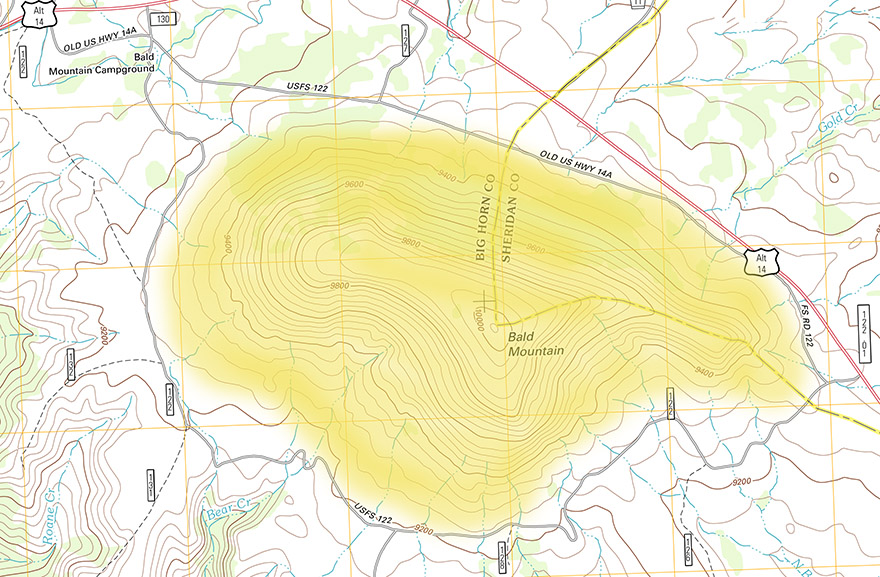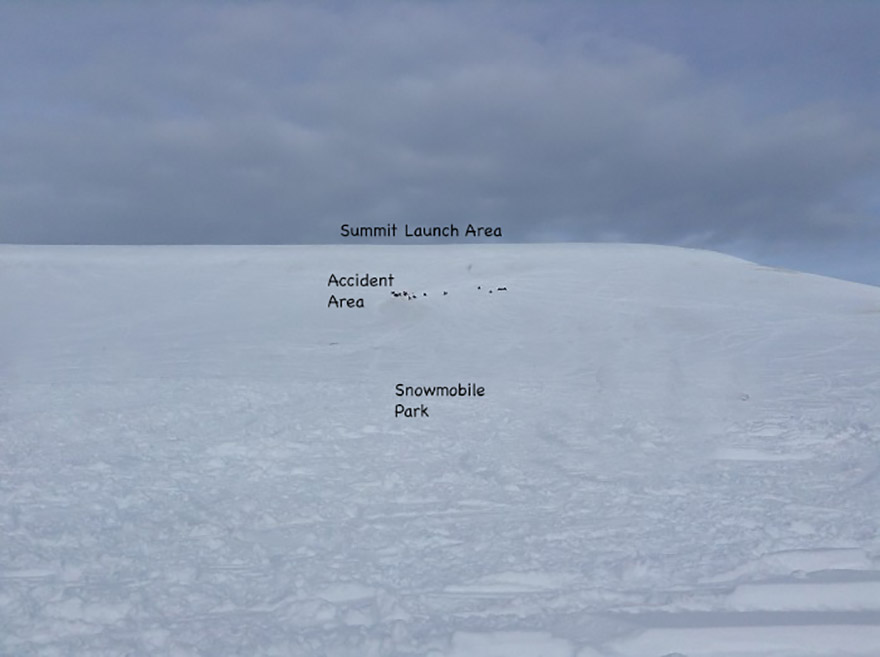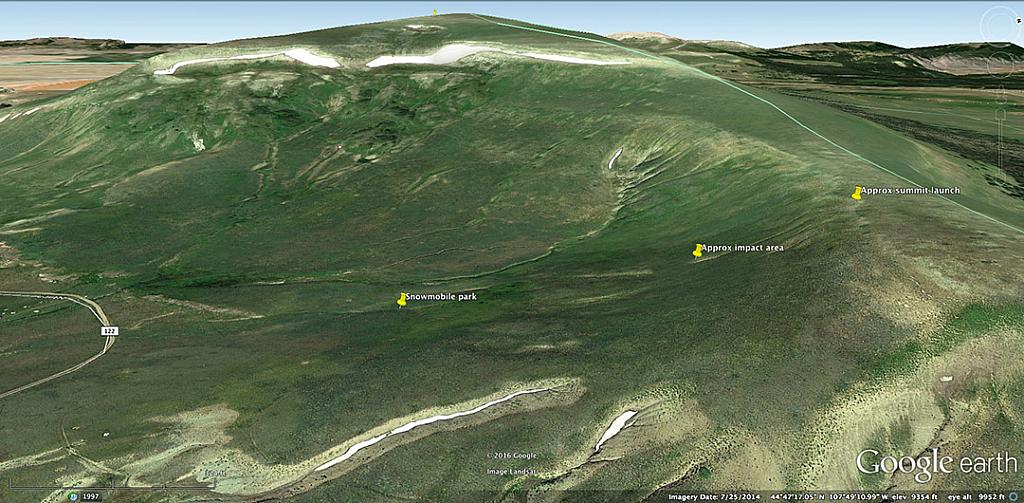
 |
|
#1
|
||||
|
||||
|
I regret posting this but hope the account may help kiters in the future. Condolences to family and friends on this tragic loss.
Summary On January 23, 2016 a Saturday at approximately 12:30 PM a man in his later 50’s suffered a fatal gliding accident while snowkiting on Bald Mountain in Wyoming.  Bald Mountain is near the Wyoming - South Dakota state lines. It has been estimated that he had been kiting for about two years and was interested in advancing in gliding particularly pulling big air using kiteboarding gear. He had attended a snowkiting summit on the same mountain in December 2015.  Gliding The snowkiting summit was intended to advance the practice of snowkiting, to allow snowkiters to meet one another and exchange ideas. He was familiar with backcountry snow operations from his work.  Bald Mountain varies in elevation between 10,000 ft. at the highest point of the mountain and around 9300 ft. NGVD at the base. The wind's were light less than 15 mph, blowing up the slope roughy from a southwest direction. There was some ridge lift evident with a high thin cloud layer. The temperature was about 32 F and warming with a major snow fall in recent days but no snow on this day. The man was observed to be doing a couple 200 ft. long or less glides off small shoulders gaining less than 15 feet off the ground typically. The demands of this scale of flying seemed to be generally within his abilities and experience based upon observer comments. He was flying a 15 m new LEI or "tube" kite.  The area of Terminal B on Bald Mountain. After lunch one well experienced snowkiter glider went up to the upper ranges of the mountain on a snowmobile to the area of "Terminal B." They kited from that point up to the area of the cornice of the mountain. The man kited up to the same launch area at the top of the mountain. This was substantially higher than where he was kiting earlier in the day and was advanced terrain for gliding. He was approximately 140 feet above where the snowmobiles were parked. There was a long gradual slope between those two points.  A Google Earth view some the rough locations and approximate elevations of the summit launch (9590 ft.), accident area (9450 ft.) and snowmobile parking area (9330 ft.). The well experienced snowkiter had launched, looked back and noticed the man had just launched and was in a slow rotation. The well experienced kiter then lost sight of him. Another kiter (also an EMT) was about 300 ft. away and heard a kite rushing through the air to slam hard into the ground. Another kiter looking overhead noticed the man's kite off to his side as he was falling rapidly about 30 to 40 ft. above the surface. His kite should have been positioned to near overhead for stable flight. The wind had blown substantial snow cover away exposing bare areas of hard frozen ground where the kiter struck. The EMT-kiter was seconds from where the kite and victim had impacted and rushed over to aid the man first hitting the quick release of both of their kites. The kiter-EMT asked that the another kiter who had come up to call for emergency medical assistance and yet another to retrieve a first aid kit if present on the sleds. They were well in the back country delaying easy, rapid response by ground-based emergency services. The kiter-EMT arrived did a primary assessment during the course of which the man stopped breathing. The kiter-EMT started CPR and continued for approximately 45 minutes. First responders arrived at the site by snowmobile within one hour from about 12 miles away after they were called at which time the kiter-EMT turned the man over to them. The exertion required for 45 minutes of CPR was very substantial particularly considering the 9000 ft.+ altitude. The kiter-EMT hung in, not willing to give up despite working to near total exhaustion to their credit. The man died at the site as a result of major impact trauma. The man was later transported to a hospital by a medevac helicopter. Analysis Based upon the limited information available it has been concluded that the man may have caught a ski edge as he left the surface putting himself into rotation. He may have panicked and pulled excessively hard on one side of the bar driving the kite downward, losing his lift and sending himself hard into the surface. Another possible explanation is that once the kiter leaves the surface, his skis will "weather vane" cross to the apparent wind. This can result in more rapid rotation but is thought to not have been the cause in this instance. Once the kite leaves the vertical and upward momentum of the kiter dissipates they will fall at speed. It is important to maintain lift when gliding well off the ground usually with the kite overhead and largely undisturbed to aid stable flight. The kite was seen to be low and off to the side of the kiter prior to impact. Snowkiters on skis may rotate around the bar to correct for the backward pull of the kite when leaving the surface. This reverses the normal bar response, e.g. pulling right turns the kiter left vs. what may be the more accustomed direction. This bar rotation may have been a source of confusion and rapid loss of kite control. Some expert kiters have concluded that his judgment was poor in electing to go to the top of the mountain at his ability level. The demands and inherent substantial risks of higher altitude gliding are not to be underestimated although it can be easy to not fully appreciate all the risks. Kiting can seem to be deceptively easy and harmless until something goes seriously wrong. Unconfirmed reported diabetes and indications of low blood sugar might have contributed to this poor judgement. If present, this might have also compromised his ability to effectively respond to the emergency after launch. The man’s kite, bar, lines and quick releases were examined for proper function. They were found to be properly inflated, correct and working properly. He was wearing a substantial climbing harness in lieu of a weaker kiteboarding harness as is becoming more common among snowkiters.
__________________
FKA, Inc. transcribed by: Rick Iossi Last edited by ricki; 03-04-2016 at 01:06 PM. |
|
|